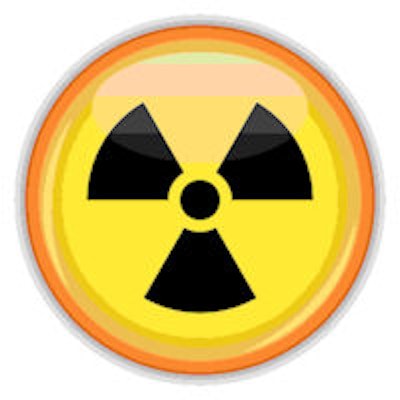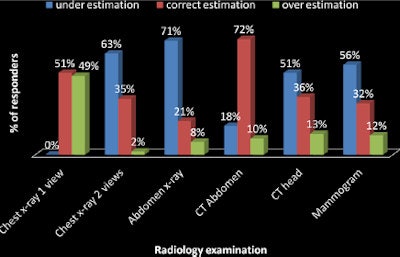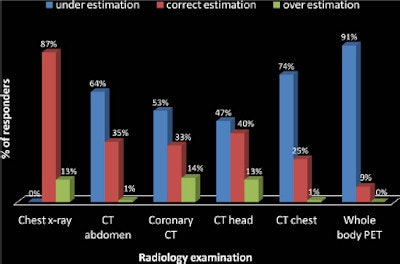
Knowledge of radiation dose and risk is poor among all radiology staff, but particularly among radiographers/technologists, and significant underestimation of dose and cancer risk is widespread, according to a new study.
"A conscientious effort to provide more robust education and acquire greater knowledge in these matters is required," noted Dr. Subramaniyan Ramanathan and Dr. John Ryan, from the Department of Diagnostic Imaging at the Ottawa Hospital in Ontario, Canada. "Staff radiologists have the most important role of acquiring and imparting the knowledge about radiation and any updates in the field to the technologists, residents, and fellows periodically, and to provide expert counsel on risk and dose issues."
A statistically significant knowledge deficit was seen in technologists compared with residents, fellows, and staff radiologists, and this is of concern because technologists are the first point of contact with the patients and they should be adequately trained to answer common patient questions and concerns, they explained in an article posted online on 21 November by Insights into Imaging. The next level of contact is residents and fellows, who are often called upon to advise colleagues in other specialties and patients about dose and safety concerns.
"It is important that we take knowledge about radiation dose and risk more seriously," the authors stated, adding that underestimating dosage and cancer risk from common examinations may lead to suboptimal risk assessment and excessive or unwarranted studies posing significant radiation hazard to the patient and radiology staff.
Their aim was to investigate and compare the knowledge of radiation dose and risk incurred in common radiology examinations. They sent an email questionnaire in January 2013 containing 17 multiple choice questions to all residents, technologists, fellows, and staff radiologists. A total of 92 responses were received from 119 questionnaires, representing a 77% response rate.
 Percentage of participants who underestimated and overestimated the effective dosage equivalents of different radiology examinations. Figures courtesy of Insights into Imaging.
Percentage of participants who underestimated and overestimated the effective dosage equivalents of different radiology examinations. Figures courtesy of Insights into Imaging. Percentage of participants who underestimated and overestimated the level of cancer risk from different radiology examinations.
Percentage of participants who underestimated and overestimated the level of cancer risk from different radiology examinations.The mean score was 8.5 out of 17, and only 48% of all participants scored more than 50% correct answers. Only 23% of respondents were aware of dose from both single-view and two-view chest x-ray, and 50% to 70% underestimated dose from common studies as well as the risk of fatal cancer. Awareness about radiation exposure in pregnancy was variable, particularly poor among technologists.
"Radiologists are expected to have pertinent knowledge to guide the referring physicians in selecting the appropriate imaging modality, based on their training in radiation dose, risk, and safety. Disappointingly, the results of this survey show significant knowledge deficit among all radiology workers, including residents, fellows, staff radiologists, and technologists," the authors wrote. "Inaccuracy is seen even in estimating the dosage of commonly performed chest x-rays."
They concede the questionnaire was not an all-inclusive one and not an ideal way of knowledge assessment with numerous limitations, but significant selective knowledge deficit was identified on typical dose levels and estimated risks of cancer induction of several important imaging examinations. Furthermore, many of the hospital's subspecialty leads and the chair of the medical imaging department were surprised and disappointed with the results.
The authors think their institution is not alone in this battle to raise awareness, but unfortunately there is little or no published data on radiation knowledge to compare with other teaching institutions. Following the survey, they are trying to enforce many of the recommendations of the American College of Radiology's (ACR) blue ribbon panel, which includes improving medical physics training during residency, particularly radiation safety topics in exit examinations. In-service training on radiation safety now take place every three months for technologists, and advanced training of selected enthusiastic technologists who can impart periodic training to other staff has been introduced.
"Periodic continuous medical educational (CME) activities are recommended among radiology workers and we are working to make this mandatory for all, including the staff radiologists irrespective of subspecialties, to update themselves on radiation dosage and risks and provide the evidence of acquired CME credits. This could help in providing optimal usage of imaging resources and minimizing the unpredictable and apparently unavoidable risk of cancer, albeit very small," they wrote. "Pre- and posteducational session assessment can be performed to assess improvement by these endeavors."
Other measures, such as including the patient's total radiation exposure in the imaging report and recording the radiation dosages in the radiology request forms, may help to create greater awareness among physicians and patients and potentially reduce the injudicious use of imaging, but this needs extensive discussion among physicians and patients for ethical concerns and practical difficulties, they advised.
In terms of future research, Ramanathan has since moved to Qatar and plans to assess the radiation knowledge there.



















